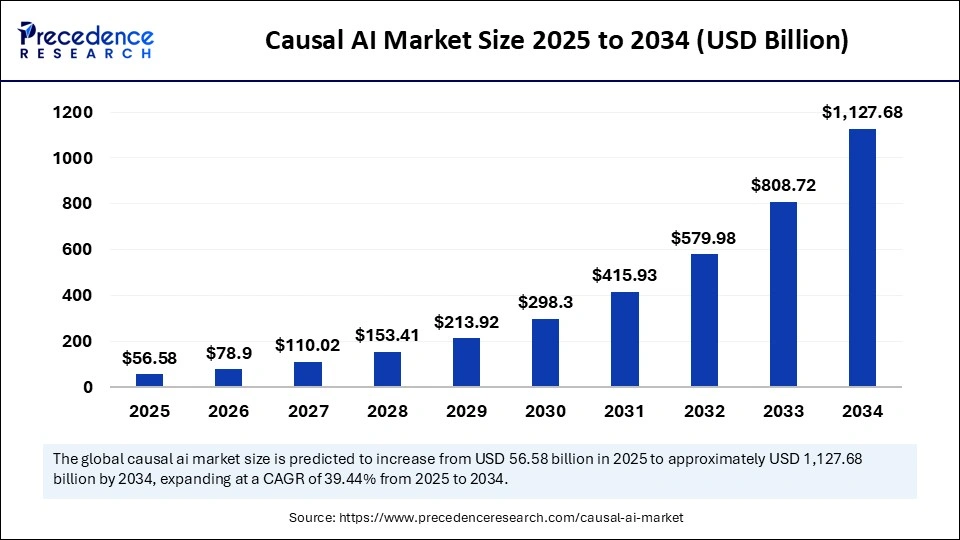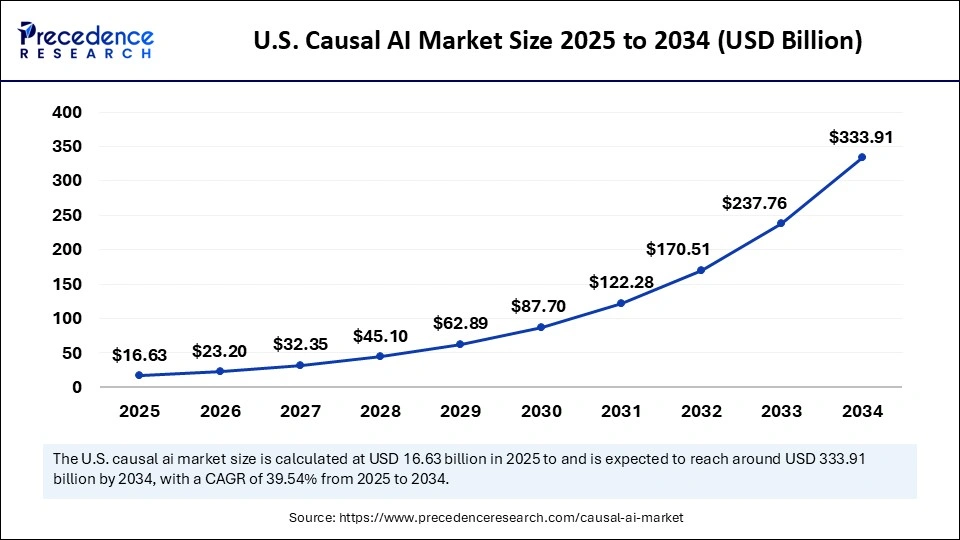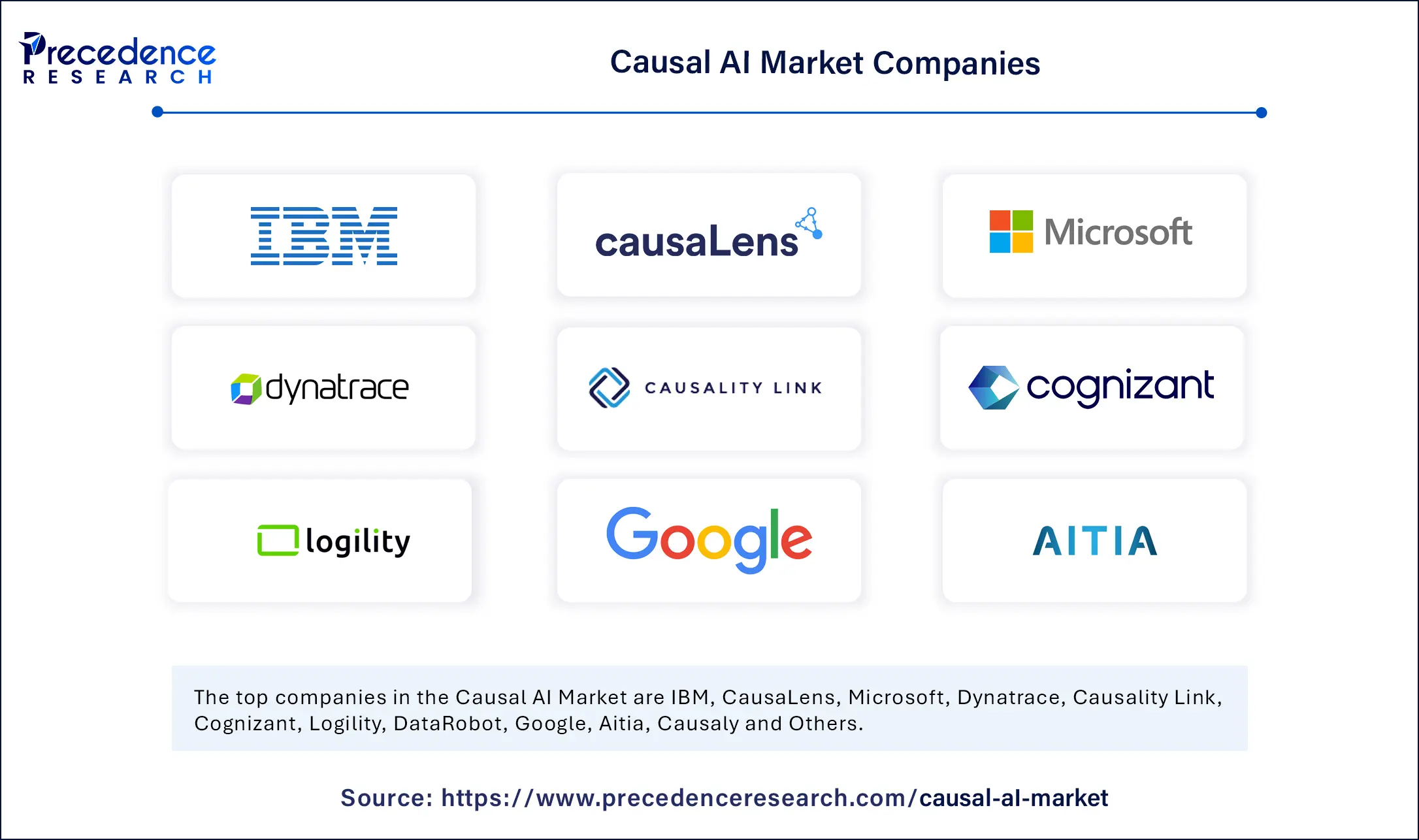List of Contents
Causal AI Market Size and Forecast 2025 to 2034
The global causal AI market size accounted for USD 40.58 billion in 2024 and is predicted to increase from USD 56.58 billion in 2025 to approximately USD 1,127.68 billion by 2034, expanding at a CAGR of 39.44% from 2025 to 2034. The growth of the market is driven by the increasing need for explainable AI and the desire for actionable insights in various industries.

Causal AI Market Key Takeaways
- The global causal AI market was valued at USD 40.58 billion in 2024.
- It is projected to reach USD 1127.68 billion by 2034.
- The market is expected to grow at a CAGR of 39.44% from 2025 to 2034.
- North America dominated the causal AI market with the largest share of 42% in 2024.
- Asia Pacific is expected to grow at the fastest CAGR between 2025 and 2034.
- By deployment, the cloud segment held the biggest market share of 56% in 2024.
- By deployment, the hybrid segment is expected to grow at the fastest CAGR during the forecast period.
- By technology, the causal interference engine segment captured the highest market share in 2024.
- By technology, the counterfactual simulation tools segment is expected to grow at the fastest CAGR in the upcoming period.
- By end-user, the healthcare and life science segment held the major market share in 2024.
- By end-user, the financial services segment is expected to grow at the fastest CAGR during the projection period.
Why Are More Businesses Turning to Causal AI?
More businesses are now turning toward causal AI as low-code and no-code platforms enable non-technical teams to automate processes, analyze data, and make decisions more quickly, all of which at a reduced cost and with faster deployment time. Businesses from a variety of industries are looking for adaptable, user-friendly artificial intelligence solutions that fit seamlessly into current workflow as digital transformation picks up speed. The growing emphasis on enhancing rather than replacing human intelligence is another factor contributing to causal AI's appeal in today's corporate environment.
U.S. Causal AI Market Size and Growth 2025 to 2034
The U.S. causal AI market size was exhibited at USD 17.04 billion in 2024 and is projected to be worth around USD 473.63 billion by 2034, growing at a CAGR of 39.54% from 2025 to 2034.

What made North America the dominant region in the causal AI market?
North America dominated the causal AI market by holding the largest share of 42% in 2024. This is mainly due to its robust startup ecosystem, sophisticated digital infrastructure, and early industry adoption of low-code and no-code platforms. The region boasts leading cloud providers and tech companies that are actively incorporating causal AI into enterprise solutions, allowing companies to enhance decision-making and automate processes without the need for technical expertise. There is high adoption of AI in healthcare, banking, and retail due to supportive funding environments and high levels of digital literacy. Startups and enterprises alike are leveraging platforms such as Salesforce Einstein, Microsoft Power Platform, and Google's Vertex AI to deploy AI solutions with minimal coding. Continuous innovation, combined with high enterprise awareness and developer community support, helped North America stay ahead in causal AI deployment.

Asia Pacific is expected to grow at the fastest rate in the coming years due to the growing adoption of mobile-first digital platforms and the growing demand for automation among small and mid-sized businesses. AI is becoming accessible to non-technical users thanks to the introduction of simple, low-setup AI tools by regional tech companies and cloud providers. Additionally, through national programs and digital upskilling initiatives, governments are fostering AI readiness, which is driving the adoption of causal AI in sectors like public services, education, and logistics. Tech hubs in countries like India, Singapore, and South Korea are witnessing a surge in AI startups, driving the development of AI tools for local languages, industries, and workflows.
Europe is expected to grow at a notable rate during the forecast period, driven by a focus on data privacy compliance, ethical AI, and enterprise-wide digital transformation. The need for no-code AI tools is being driven by the growth of citizen developers and the requirement for specialized automation solutions in the fields of public administration, finance, and manufacturing. By providing causal AI platforms tailored to local regulatory requirements, European startups are also fostering innovation. Initiatives under Europe's Digital Decade policy and increased AI funding from the European Commission are driving adoption and innovation. Strict GDPR compliance has also driven the demand for AI tools that are transparent, explainable, and built with a privacy-first framework.
Market Overview
The causal AI market is growing rapidly as companies are shifting toward low-code and no-code AI tools that are easy to use and enable non-technical users to automate processes, analyze data, and assist in decision-making. Small and mid-sized businesses find these tools particularly appealing because they are affordable, quick to implement, and simple to integrate with current business systems. The rising applications of causal AI in marketing, human resources, customer service, and various other operations are boosting the growth of the market. The surge in digital transformation, rising cloud adoption, and the move toward augmented intelligence, where AI complements human input rather than replaces it, contribute to market expansion.
Why Are More Businesses Turning to Causal AI?
More businesses are now turning toward causal AI as low-code and no-code platforms enable non-technical teams to automate processes, analyze data, and make decisions more quickly, all of which at a reduced cost and with faster deployment time. Businesses from a variety of industries are looking for adaptable, user-friendly AI solutions that fit seamlessly into current workflow as digital transformation picks up speed. The growing emphasis on enhancing rather than replacing human intelligence is another factor contributing to causal AI's appeal in today's corporate environment.
Causal AI Market Growth Factors
- Easy to use: No code and low code tools make AI accessible to non-technical users.
- High demand for automation: Businesses want to automate routine tasks and decision-making, boosting the adoption of causal AI.
- Rising digital transformation: Companies across sectors are adopting digital tools, boosting the need for simplified AI solutions.
- Expanding use cases: From marketing and HR to customer support and finance, causal AI is being applied in diverse business areas.
- Cost-effective: Lower development costs and faster development of causal AI tools attract SMEs.
- Smooth integration: Causal AI tools can be easily connected with existing software like CRM and ERP, leading to their higher adoption.
Market Scope
| Report Coverage | Details |
| Market Size by 2034 | USD 1,127.68 Billion |
| Market Size in 2025 | USD 56.58 Billion |
| Market Size in 2024 | USD 40.58 Billion |
| Market Growth Rate from 2025 to 2034 | CAGR of 39.44% |
| Dominating Region | North America |
| Fastest Growing Region | Asia Pacific |
| Base Year | 2024 |
| Forecast Period | 2025 to 2034 |
| Segments Covered | Deployoment, Technology, End User, and Region |
| Regions Covered | North America, Europe, Asia-Pacific, Latin America, and Middle East & Africa |
Market Dynamics
Drivers
Need for Cost-Effective AI Solutions
The rising need for cost-effective AI solutions across industries is a major factor driving the growth of the causal AI market. With subscription-based or usage-based pricing models, causal AI tools lower development and maintenance costs. Because of this, even SMEs with tight budgets can use AI. Moreover, they frequently operate entirely in the cloud and demand little infrastructure investment. Pay-as-you-go reduces financial risk and facilitates incremental growth. As ROI becomes a top priority for businesses causal AI flexibility and affordability become strong points.
- On 2 December 2024, the browser company launched Dia, an AI-powered browser that automates routine web tasks like summarizing pages and adding products to carts, showcasing how accessible AI can reduce workload at minimal cost.
(Source: https://www.theverge.com)
Rising Demand for No-Code/Low-Code Tools
AI development is made simpler by no-code platforms, which makes it simple for non-technical users to create and implement models. This trend is reducing reliance on data scientists and promoting departmental innovation more quickly. It also shortens the time to insight, allowing HR departments and marketers to start AI-powered workflows in a matter of days rather than months. Businesses can test AI in practical business settings by reducing the technical barrier. This change essentially makes all departments capable of innovation in AI.
- On 12 June 2025, Krutrim introduced its AI assistant Kruti, an agentic AI tool capable of autonomously handling user tasks without manual inputs, aligning perfectly with the no-code AI trend.
(Source: https://m.economictimes.com)
Restraints
Data Privacy & Security Concerns
There is a greater chance of data breaches, illegal access, and regulatory noncompliance because many causal AI tools process sensitive enterprise data or third-party data. Most nascent platforms find it difficult to comply with regulatory frameworks like the GDPR, India’s DPDP Act, and EU AI Act, which demand stringent transparency and governance. Issues like algorithmic bias, data privacy, and the potential for misuse raise ethical concerns. Thus, businesses are hesitant to use causal AI for important reasons because of these factors.
Limited Customization & Scalability
Despite their simplicity, causal AI platforms frequently lack the adaptability to manage large-scale data workloads or complex domain-specific models, which hampers the growth of the causal AI market. When tasks call for sophisticated turning, unique model architectures, or integration with legacy systems, they fall short despite providing prebuilt templates and simple workflows. When use cases increase in volume and complexity, businesses usually encounter functional limits and are forced to go back to more conventional AI engineering approaches. In advanced scenarios, this mismatch may lead to a shift away from causal AI platforms, which would negatively impact retention and restrict enterprise adoption. Moreover, integrating AI into existing systems can be complex, limiting the adoption of causal AI.
Opportunities
Expansion into Voice & Conversational AI
New avenues for consumer interaction and operational effectiveness are provided by voice-first and conversational AI. Businesses can improve user experience, increase accessibility, and get around traditional IVR systems by using no-code platforms that let them create multilingual voice agents. In emerging markets where voice interfaces can get around limitations related to literacy and typing, this opportunity is especially strong. Voice-based agents can also be quickly implemented in a variety of languages and platforms, giving SMEs a global presence.
- On 29 May 2025, a Bengaluru-based Ringg AI introduced a platform that enables businesses to deploy real-time, multilingual voice assistants without coding, supporting 15+ languages and powering customer support in regions like India, the Middle East, and Latin America.
(Source: https://www.indiatimes.com)
Integration of No-Code Tools into Large Cloud AI Platforms
By integrating non-code AI tools into their platforms, top cloud and AI providers are democratizing the deployment and implementation of models in enterprise ecosystems. This makes it easier for businesses to implement AI by enabling users to create, evaluate, and experiment with content within well-known workflows. Rapid value creation while preserving enterprise-grade compliance and scalability benefits both developers and end users.
- On 12 November 2024, Baidu world CEO Robin Li unveiled Miaoda as part of the Ernie platform suite, enabling users to build AI-powered apps without coding and integrating them via cloud services alongside text-to-image and agent functionalities.
(Source: https://www.reuters.com)
Deployment Insights
Why did the cloud segment dominate the causal AI market?
The cloud segment dominated the causal AI market with the largest revenue share of 56% in 2024, as it offers unparalleled scalability, remote accessibility, and rapid integration with existing digital infrastructure. Without having to make significant upfront investments in IT staff or hardware, cloud platforms enable businesses to implement AI solutions. Additionally, cloud-based Causal AI tools are now the go-to choice across industries due to ongoing updates of security patches and support for international collaboration. Cloud-based solutions facilitate smooth integrations with analytics dashboards, SaaS apps, and APIs. Startups and mid-sized businesses gain a lot from being able to test AI at a minimal cost. The adoption of non-code AI is further accelerated by the built-in support offered by top providers like AWS, Google Cloud, and Microsoft Azure.
The hybrid segment is expected to grow at the fastest rate during the forecast period, as security compliance and flexible data control are becoming more and more important. To keep sensitive data on-premises while utilizing the scalability and speed of cloud AI tools, organizations in regulated industries like banking and healthcare favor hybrid models. The adoption of hybrid causal AI solutions is rising as they strike a balance between control and innovation. Phased AI rollout is another benefit of hybrid deployment, which enables businesses to test tools in a restricted setting before a full-scale cloud migration. For large businesses, the hybrid cloud connects outdated systems with contemporary interfaces. The hybrid trend is also being pushed forward by growing cybersecurity concerns.
Technology Insights
What made causal interference engines the dominant segment in 2024?
The causal interference engines segment dominated the market with a major revenue share in 2024 as they simplify AI for everyday users. With the help of these tools, non-technical employees can create and oversee AI workflows using visual dashboards, drag-and-drop functionality, and natural language prompts. Their widespread adoption across business verticals is fueled by their ease of use, which makes them perfect for teams in charge of marketing, human resources, and customer service. Project timelines are shortened and reliance on IT departments decreases when intelligent workflows can be created without coding. More intelligent no-code automation tools are emerging because of well-known platforms like Bubble App Smith and Zapier incorporating AI engines into their interface layers. The development of enterprise software is being transformed by this user-first design.
The counterfactual simulation tools segment is expected to grow at the fastest rate in the upcoming period, as these tools improve decision-making. In fields like finance, logistics, and strategic planning, these tools are particularly helpful. Such user-friendly simulation capabilities are becoming more and more in demand as companies look for data-driven insights without needing deep AI knowledge. These tools are becoming more popular for operational forecasting, policy testing, and risk mitigation. Strategic planning procedures are revolutionized by their use of investor-optimizing scenario planning and ESG reporting. Investor interest and early enterprise pilots are being observed in startups that provide plug-and-play simulation engines.
End-User Insights
Why does the healthcare & life sciences segment dominate the market?
The healthcare & life sciences segment dominated the causal AI market with a major share in 2024 due to its pressing need for workflow automation, patient data analysis, and clinical decision support. By enabling healthcare workers to automate processes like medical transcription, appointment scheduling, and diagnostic assistance, no-code AI platforms enhance patient outcomes and operational effectiveness. AI is also being used by hospitals and research facilities to infer information from imaging data and clinical records without coding. These tools lessen human error and ease the workload for administrative staff. The industry is adopting AI more quickly due to growing healthcare digitization and cost-efficiency pressures.
The financial services segment is expected to grow at the fastest rate during the projection period due to the strong emphasis of financial institutions on fraud detection, risk analysis, and customer customization. Banks and fintech companies can automate data-intensive processes and produce predictive insights with causal AI tools without having to create custom models from scratch. The industry's drive for AI-driven compliance and efficiency is accelerating adoption. AI is being used more and more by banks in their portfolio management, credit scoring, and onboarding procedures. Nowadays it's typical to find chatbots, loan processors, and underwriting systems constructed with non-code platforms. Even established businesses are being forced to use AI tools more nimbly due to competitive pressure and regulatory sandboxes that facilitate experimentation.
Causal AI Market Companies

Recent Developments
- In June 2025, DATA POEM, an AI-first company that pioneered the field of Horizontal Causal Intelligence, announced the launch of POEM365, a causal AI model. This revolutionary product marks the debut of the world's first and only Large Causal (AI) Model (LCM), designed to transform how enterprises across automotive, CPG, retail, and e-commerce sectors leverage data for mission-critical decision-making.
(Source: https://www.businesswire.com)
- On 9 June 2025, Chinese social media company Rednote released open-source LLM dots. Llm1, a large language model openly available on Huggin Face, pushes the trend of open-source AI while offering capabilities akin to Alibaba Qwen2.5, including coding tasks.
(Source: https://www.reuters.com)
Segments Covered in the Report
By Deployment
- Cloud
- On-premises
- Hybrid
By Technology
- Causal Inference Engines
- Structural Causal Models (SCM)
- Counterfactual Simulation Tools
- Graph-Based Causal Modeling
- Others
By End-User
- Healthcare & Life Sciences
- Financial Services
- Retail & E-commerce
- Manufacturing
- Government & Public Sector
- Technology & IT Services
- Others
By Region
- North America
- Europe
- Asia Pacific
- Latin America
- Middle East and Africa (MEA)
For inquiries regarding discounts, bulk purchases, or customization requests, please contact us at sales@precedenceresearch.com
Frequently Asked Questions
Ask For Sample
No cookie-cutter, only authentic analysis – take the 1st step to become a Precedence Research client